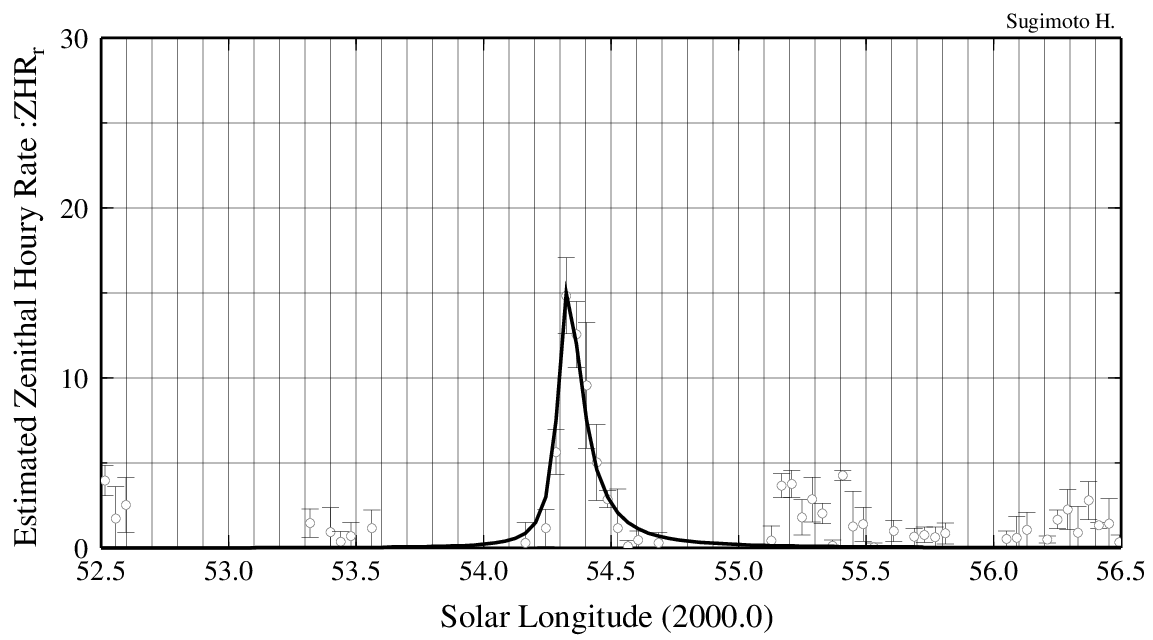Hiroshi Ogawa and Hirofumi Sugimoto
Abstract: Possible meteor activity connected to the minor planet 2006GY2 had been predicted for 15th May 2022. Worldwide radio meteor observers caught meteor activity possibly related to it. The peak was detected at λʘ = 54.325°–54.365° (May 15, 11h30m – 12h30m UT). The Activity Level Index (AL) was estimated as AL = 0.4 and the estimated ZHRr was 15.
1 Introduction
An encounter with meteoroids released from minor planet 2006GY2 was expected on May 15 around 10h20m (λʘ = 54.28°) (Rendtel, 2021).
Using radio meteor observation it is possible to observe meteor activity continuously even with bad weather or during daytime. Besides, the problem of the radiant elevation is solved by organizing a worldwide project. One of the worldwide projects is the International Project for Radio Meteor Observations (IPRMO). IPRMO uses the Activity Level index for analyzing meteor shower activity (Ogawa et al., 2001).
2 Method
This research adopted two methods for estimating the meteor shower activity. One is the Activity Level Index which is used by IPRMO (Ogawa et al., 2001). Another is the estimated ZHRr (Sugimoto, 2017). This index is estimated by using the Activity Level index and a factor named Sbas which translates the Activity Level index to ZHRr. This method is very useful to compare radio observations to visual observations.
3 Results
Figure 1 shows the result based on the calculation of the Activity Level Index using 39 sets of observing data from 11 countries. The peak occurred at λʘ = 54.365° (May 15, 12h30m UT). The Activity Level Index was 0.4 ± 0.3 with Full Width of Half Maximum (FWHM) –1.5hrs / +3.0hrs. The distinct activity remained for three hours according to the result of the Activity Level Index.

Figure 1 – Activity Level Index.
Figure 2 shows the estimated ZHRr using 33 observations from the world. The estimated ZHRr was 15 ± 2 at λʘ = 54.325° (May 15, 11h30m UT). The activity started at λʘ = 54.245° (May 15, 9h30m UT) and ended at λʘ = 54.566° (May 15, 17h30m UT).

Figure 2 – Estimated ZHRr.
Table 1 – Activity Level Index (AL) and estimated ZHRr.
| Time (UT) | λʘ | Activity Level | ZHRr | ||
| N | AL | N | ZHRr | ||
| May 15 9h30m | 54.245 | 18 | -0.0±0.1 | 7 | 1±1 |
| May 15 10h30m | 54.285 | 16 | 0.0±0.1 | 10 | 6±1 |
| May 15 11h30m | 54.325 | 15 | 0.3±0.1 | 15 | 15±2 |
| May 15 12h30m | 54.365 | 17 | 0.4±0.3 | 12 | 13±2 |
| May 15 13h30m | 54.405 | 15 | 0.3±0.2 | 8 | 10±4 |
| May 15 14h30m | 54.445 | 12 | 0.2±0.1 | 9 | 5±2 |
| May 15 15h30m | 54.486 | 11 | 0.2±0.1 | 9 | 3±1 |
4 Discussion
Figure 3 and Figure 4 show the estimated components of the Activity Level and ZHRr which were calculated by using the Lorentz profile (Jenniskens et al., 2000). It had a maximum Activity Level = 0.4 and ZHRr = 15 at λʘ = 54.325°–54.365° (May 15, 11h30m–12h30m UT) with Full width half maximum (FWHM) = –1.0 / +2.0 hours. The descending branch was longer than the ascending branch. Although this result may indicate a possible meteor activity related to 2006GY2, we need to keep in mind that the Activity Level Index was very weak.

Figure 3 – Activitiy Level: Estimated components using the Lorentz Profile.

Figure 4 –ZHRr: Estimated components using the Lorentz Profile.
Table 2 – Estimated components of meteor activity (Activity Level is reference values).
| Peak Time | λʘ | Peak Level | FWHM (hours) | |
| ZHRr | May 15 11h30m UT | 54.325˚ | 15 | -1.0/+2.0 |
| Activity Level | May 15 12h30m UT | 54.365˚ | 0.4 | -1.5/+3.0 |
Acknowledgment
The worldwide data were provided by the Radio Meteor Observation Bulletin (RMOB). The following observers provided data:
Chris Steyaert (Belgium), Felix Verbelen (Belgium), Johan Coussens (Belgium), HFN-R1 (Czech Republic), OBSUPICE-R6 (Czech Republic), VALMEZ-R1 (Czech Republic), DanielD SAT01 DD (France), Jean Marie F5CMQ (France), Balogh Laszlo (Hungary), Istvan Tepliczky (Hungary), Mario Bombardini (Italy), Hirofumi Sugimoto (Japan), Hironobu Shida (Japan), Hiroshi Ogawa (Japan), Kenji Fujito (Japan), Masaki Kano (Japan), Masaki Tsuboi (Japan), Nobuo Katsura (Japan), Norihiro Nakamura (Japan), Juan Zapata (Mexico), Rainer Ehlert (Mexico), Salvador Aguirre (Mexico), Karlovsky Hlohovec Observatory (Slovakia), Jochen Richert (Switzerland), Jochen Richert 1 (Switzerland), Ian Evans (UK), Philip Norton (UK), Philip NortonVert (UK), Philip Rourke (UK), Eric Smestad KC0RDD (USA), Mike Otte (USA), Richard Schreiber (USA), Stan Nelson (USA)
We wish to thank Pierre Terrier for developing and hosting rmob.org.
References
Jenniskens P., Crawford C., Butow S. J., Nugent D., Koop M., Holman D., Houston J., Jobse K., Kronk G., and Beatty K. (2000). “Lorentz shaped comet dust trail cross section from new hybrid visual and video meteor counting technique imprications for future Leonid storm encounters”. Earth, Moon and Planets, 82–83, 191–208.
Ogawa H., Toyomasu S., Ohnishi K., and Maegawa K. (2001). “The Global Monitor of Meteor Streams by Radio Meteor Observation all over the world”. In, Warmbein Barbara, editor, Proceeding of the Meteoroids 2001 Conference, 6-10 August 2001, Swedish Institute of Space Physics, Kiruna, Sweden. ESA Publications Division, European Space Agency, Noordwijk, The Netherlands, 189–191.
Rendtel J. (2021). “2022 Meteor Shower Calendar”. International Meteor Organization
Sugimoto H. (2017). “The New Method of Estimating ZHR using Radio Meteor Observations”. eMetN, 2,
109–110.


